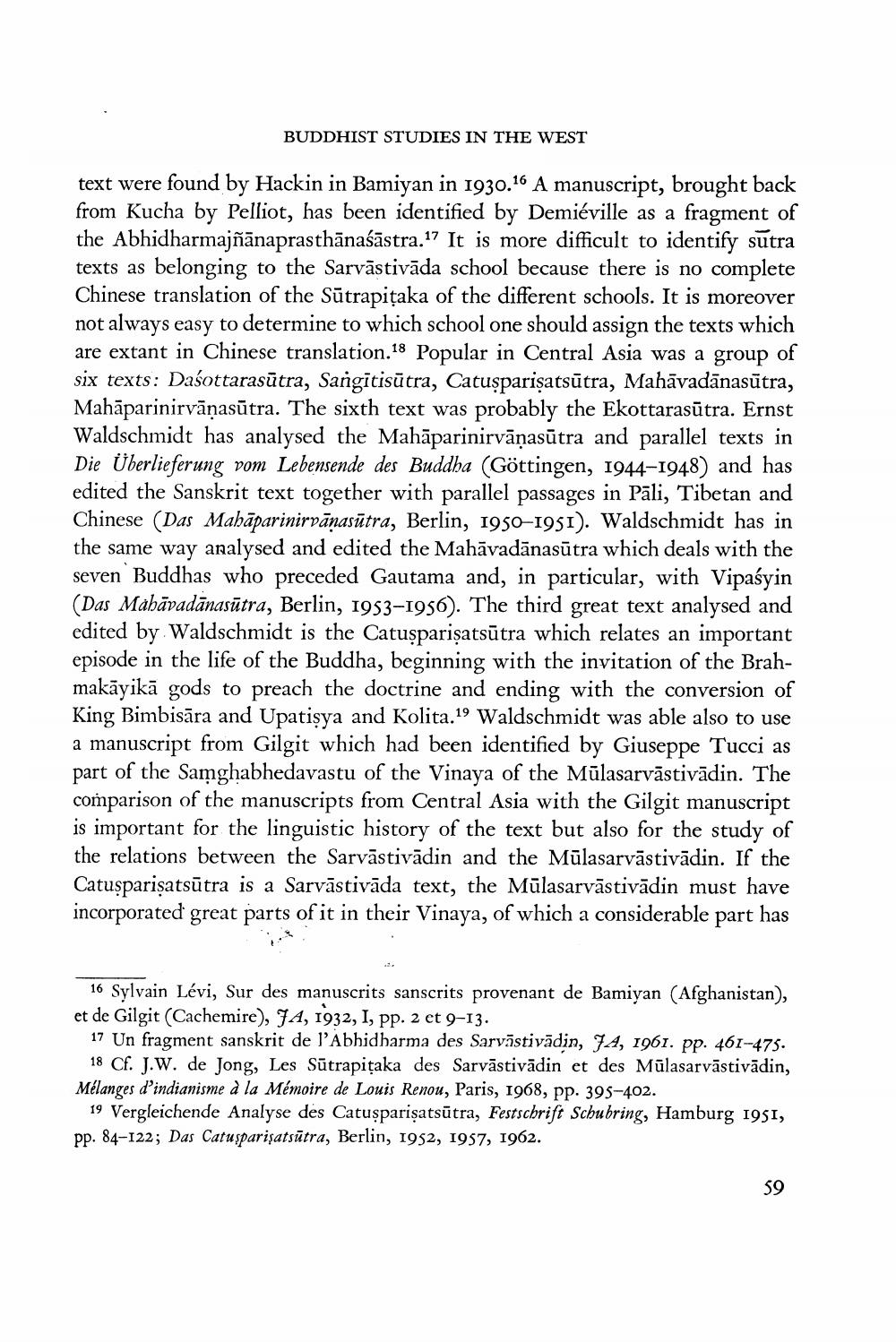________________
BUDDHIST STUDIES IN THE WEST
text were found by Hackin in Bamiyan in 1930.16 A manuscript, brought back from Kucha by Pelliot, has been identified by Demiéville as a fragment of the Abhidharmajñānaprasthānaśāstra.?? It is more difficult to identify sutra texts as belonging to the Sarvāstivāda school because there is no complete Chinese translation of the Sūtrapitaka of the different schools. It is moreover not always easy to determine to which school one should assign the texts which are extant in Chinese translation.18 Popular in Central Asia was a group of six texts: Dasottarasūtra, Sangitisūtra, Catusparisatsūtra, Mahāvadānasūtra, Mahāparinirvānasūtra. The sixth text was probably the Ekottarasūtra. Ernst Waldschmidt has analysed the Mahāparinirvānasūtra and parallel texts in Die Überlieferung vom Lebensende des Buddha (Göttingen, 1944-1948) and has edited the Sanskrit text together with parallel passages in Pāli, Tibe Chinese (Das Mahāparinirvāṇasūtra, Berlin, 1950–1951). Waldschmidt has in the same way analysed and edited the Mahāvadānasūtra which deals with the seven Buddhas who preceded Gautama and, in particular, with Vipaśyin (Das Mahāvadānasūtra, Berlin, 1953-1956). The third great text analysed and edited by Waldschmidt is the Catusparişatsūtra which relates an important episode in the life of the Buddha, beginning with the invitation of the Brahmakāyikā gods to preach the doctrine and ending with the conversion of King Bimbisāra and Upatisya and Kolita.19 Waldschmidt was able also to use a manuscript from Gilgit which had been identified by Giuseppe Tucci as part of the Samghabhedavastu of the Vinaya of the Mūlasarvāstivādin. The comparison of the manuscripts from Central Asia with the Gilgit manuscript is important for the linguistic history of the text but also for the study of the relations between the Sarvāstivādin and the Mūlasarvāstivādin. If the Catusparişatsūtra is a Sarvāstivāda text, the Mūlasarvāstivādin must have incorporated great parts of it in their Vinaya, of which a considerable part has
16 Sylvain Lévi, Sur des manuscrits sanscrits provenant de Bamiyan (Afghanistan), et de Gilgit (Cachemire), JA, 1932, 1, pp. 2 et 9-13.
17 Un fragment sanskrit de l'Abhidharma des Sarvāstivādin, 7A, 1961. pp. 461-475. 18 Cf. J.W. de Jong, Les Sūtrapitaka des Sarvāstivādin et des Mūlasarvāstivādin, Mélanges d'indianisme à la Mémoire de Louis Renou, Paris, 1968, pp. 395-402.
19 Vergleichende Analyse des Catusparişatsūtra, Festschrift Schubring, Hamburg 1951, pp. 84-122; Das Catusparisatsūtra, Berlin, 1952, 1957, 1962.




